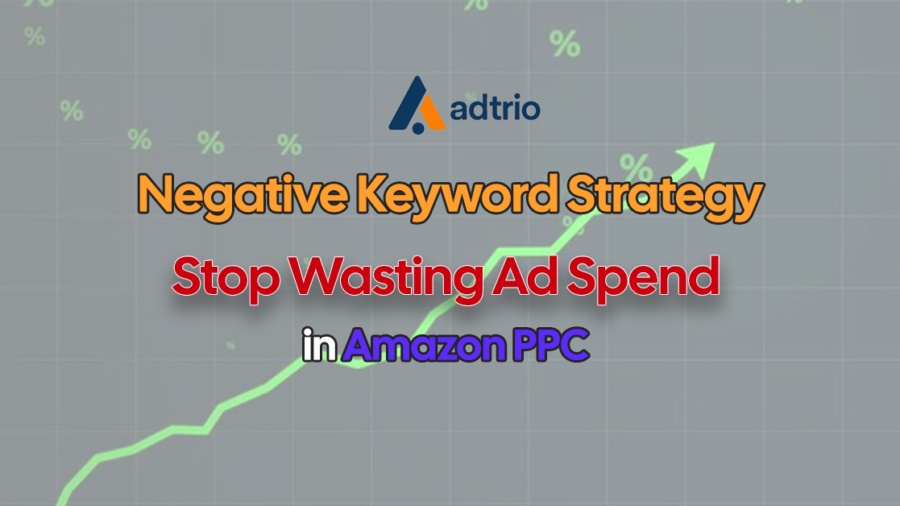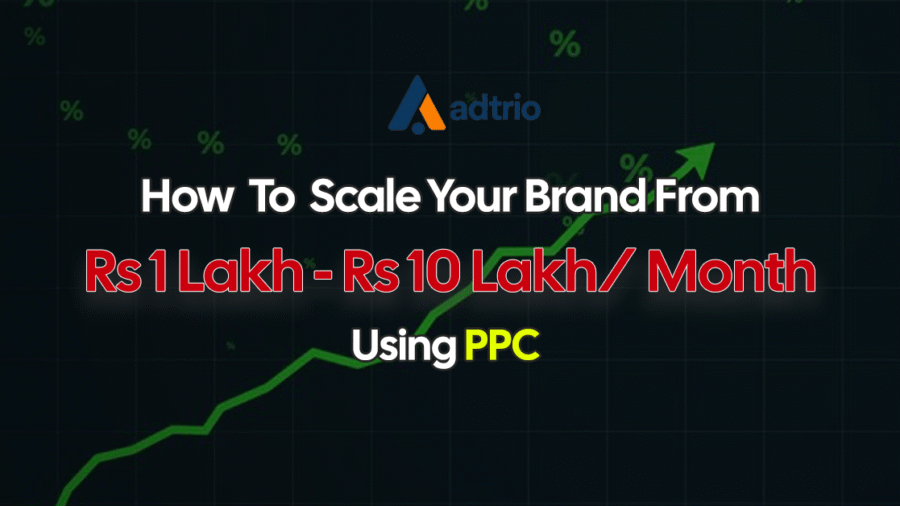Many Amazon sellers struggle with high ad spend and low returns because their ads reach irrelevant audiences. This often happens when their campaigns lack an effective negative keyword strategy. Using negative keywords lets sellers prevent ads from showing on unrelated or low-converting searches, ultimately reducing wasted spend and improving campaign efficiency.
Negative keywords act as filters that hold away unqualified traffic. By wisely choosing which terms to remove, sellers may sharpen targeting and focus on shoppers that are more likely to convert, thus ensuring that ad dollars are spent on the right customers. This option does not only save money but it also boosts the general PPC performance by concentrating efforts where it really matters.
The advertising space in Amazon is getting more competitive with time, thus making the need for optimizing every single area of the campaign very important. Negative keywords, therefore, constitute a very simple yet powerful way to refine ad delivery, increase ROI, and control how budgets are allocated in Sponsored Product and Brand campaigns.
Understanding Negative Keywords in Amazon PPC
Negative keywords shape Amazon PPC campaigns by blocking irrelevant search terms. And, they target ads and tell them where not to go to reduce waste of budget. Having a clear definition of negative keywords, their types, and how they affect ad spend must be well-heavy in any effective campaign management.
What Are Negative Keywords?
Negative keywords are certain words or phrases that block ads from being displayed for particular customer searches. When adding negatives to their Amazon PPC campaigns, ads do not appear for search queries containing such terms.
This saves the cost of irrelevant clicks by users who are unlikely to convert and makes the ads more efficient. For instance, a seller with the premium-line headphones could put in “cheap” as a negative keyword, thereby preventing ads from showing to those shoppers searching by budget.
That allows sellers to exclude undesired traffic with negative keywords and buy ad space only for high-intent shoppers who are actively searching for their products.
Types of Negative Keywords
There are three primary types of negative keywords in Amazon PPC:
- Negative Broad Match: Ads won’t show if the search query contains the negative keyword anywhere in the phrase. It’s the widest filter.
- Negative Phrase Match: Ads won’t show if the exact phrase appears in the search query, but other words can be present.
- Negative Exact Match: Ads won’t show only if the search query exactly matches the negative keyword.
Choosing the right match type helps sellers control campaign reach precisely. Broad match blocks more queries but risks over-blocking potential buyers. Phrase and exact matches offer more targeted filtering but need careful management to avoid missed opportunities.
Why Negative Keywords Matter for Ad Spend
Negative keywords prevent an Amazon Sponsored Products campaign from appearing on search terms that are irrelevant or very unlikely to convert. They thus directly reduce wasteful ad spend in Amazon PPC campaigns. Sellers without negative keywords often find their budgets inefficiently allocated, paying for clicks that rarely result in sales.
A strong negative keyword strategy decreases ACoS by lowering the costs while keeping conversions intact. It also increases ROAS by ensuring that every ad dollar is spent on qualified shoppers.
On a highly competitive Amazon marketplace landscape, any minor inefficiency can sum up quickly. Negative keywords aid sellers in sharpening campaign focus, increasing profitability, and staying competitive without increasing their ad budget.
Building a Negative Keyword Strategy for Amazon Ads
The right kind of negative keyword strategy focuses on denying irrelevant traffic to save budget and ensure that ads work well for advertisers. Locating wrong search terms, making lists with keywords, and then applying them in the right way to all campaigns and ad groups comprises such a strategy.
Identifying Irrelevant Search Terms
Building a profitable set of Amazon negative keywords starts with the analysis of search term reports. These reports outline queries that trigger ads but that do not convert or, in some cases, attract buyers that are totally unrelated.
Terms with high impressions and low click-through or conversion rates are the go-to; some of the usual suspects for irrelevant searches include misspellings or competitor brand names or products outside the seller’s niche. Blocking these by adding them as negative keywords is how sellers avoid wasting ad revenues.
Since search behavior keeps evolving, sellers need to make sure to keep on monitoring their negative keywords and updating them. Amazon’s advertising dashboard or third-party tools allow one to spot quickly poor-performing search terms.
Structuring Your Negative Keyword Lists
Creating organized negative keyword lists improves ad management and campaign scalability. Sellers should group negative keywords by theme, product type, or match type for precision.
For instance, broad negatives block a wide range of unrelated searches, while phrase or exact match negatives allow more control by blocking specific queries only. Proper matching helps avoid accidentally excluding relevant traffic.
A well-structured list lets sellers apply the same negative keywords across multiple campaigns, saving time and maintaining consistency. Regular audits ensure that lists remain up-to-date and effective.
Setting Negative Keywords at Campaign and Ad Group Level
A good explanation of the different levels and their purposes for setting negative keywords is necessary. At the campaign level, negative keyword terms are excluded in all ad groups; it’s useful in that it is a befitting block against irrelevant traffic in broad terms.
Ad group-level negative keywords are more granular in the exclusions and allow different keywords for diverse products or targeting strategies within the same campaign.
This use of the mix toolbox gives you the most precision. For example, less relevant terms get blocked at the campaign level, whereas really niche negatives get applied within selected ad groups. Such layering helps in rationing the budget and makes ads more relevant.
Implementing Negative Keywords Across Campaign Types
Effective use of negative keywords requires understanding their match types and how they work differently in automatic and manual campaigns. This approach refines ad targeting and reduces wasted spend in Amazon PPC campaigns.
Negative Keyword Match Types
There are three primary negative keyword match types used in Amazon PPC: negative exact, negative phrase, and negative broad.
- Negative Exact: Blocks specific search terms exactly as they appear. This is the most precise method to exclude irrelevant or low-performing keywords without affecting similar variations.
- Negative Phrase: Prevents ads from showing if the entire phrase appears in the search query in the same order. It allows broader exclusion while still controlling relevance.
- Negative Broad: Blocks any search query containing the negative keyword in any order or alongside other terms. It is powerful but can risk excluding potentially relevant traffic if used too aggressively.
Choosing the right match type depends on campaign goals, keyword performance data, and how strictly irrelevant traffic needs to be excluded.
Using Negative Keywords in Automatic vs. Manual Campaigns
In Automatic campaigns, Amazon matches ads to search queries without direct keyword targeting. Negative keywords here help prevent ads from showing on irrelevant or unprofitable searches, improving spend efficiency by quickly cutting wasted clicks.
In Manual campaigns, advertisers select keywords directly. Negative keywords serve to fine-tune targeting by excluding searches that trigger ads under broad or phrase matches. They also help avoid overlap between campaigns and reduce internal competition.
Effective negative keyword management requires constant analysis, especially in manual campaigns, where keyword granularity is higher. For automatic campaigns, reviewing search term reports regularly guides which negatives to apply to block unnecessary spend.
Ongoing Optimization and Best Practices
Negative keyword refinement should continue for the duration of your campaigns to keep their efficiency intact and avoid wasting expensive ad budgets. This process entails examining data, carefully modifying negative keyword lists, and finding the right balance so as not to block any legitimate traffic.
Regular Search Term Report Analysis
Checking the search term report frequently can let advertisers identify irrelevant queries that trigger ads. He or she must try to find keywords that got impressions or clicks but never converted. Always filter and check terms with few conversions and high costs to identify those that need to be added to the negative keywords.
Never look only at the obvious keywords. Variations, misspellings, and even unrelated search phrases that drain budget must be added as negatives. It is wise to review the negative list every week or every two weeks for alignment with changes in consumer behavior and Amazon’s search algorithm.
Iterate Negative Keyword Lists
Negative keyword lists are never static and thus require iteration. Ideally, the negative keywords should be expanded gradually based on new data from reports, for which every new negative should be safely tested to ensure that they do not block valuable impressions inadvertently.
Breaking down negatives by match types-broad, phrase, and exact-will allow fairly granular tuning, where, for example, phrase match negatives may block a certain word sequence but allow related variations. An organized and categorized list would eventually make future management and optimization far easier.
Avoiding Over-Negativization
An increased number of negative keywords could block the campaign reach and the opportunity for sales. He or she must avoid blanket-type negatives that exclude wide sets of queries without a good analysis.
Testing is required to understand the impact of negative keywords before fully investing in a negative keyword. One may want to remove a negative keyword if the number of clicks may increase, or if the conversion rate stands to increase. One wants to cut waste yet not cut into visibility for genuine earnings.
Advanced Tactics to Prevent Wasted Ad Spend
Effective management of negative keywords requires ongoing refinement and strategic integration with overall campaign goals. Leveraging automation tools and incorporating negative keywords systematically enhances precision and reduces irrelevant ad spend.
Negative Keyword Automation Tools
Automation techniques ensure a competent identification and management of negative keywords within Amazon PPC. The tools scan through the search term reports to identify those keywords behind irrelevant traffic or conversions that are really draining of the budget. Automating the process saves time and also reduces errors on behalf of advertisers.
Some popular tools offer features like automatic negative keyword suggestion, bulk negative keyword uploads, and performance tracking for rapid adaptation of campaigns to ever-changing search trends.
Also, applying negative keywords ensures that manual intervention will not be able to undermine it as it stands on its own across multiple campaigns. Advertisers foster a cleaned-up keyword list while keeping it less likely to squander more money trying to track irrelevant clicks, therefore enhancing the efficiency of the entire campaign.
Integrating Negative Keywords With Overall PPC Strategy
Incorporating negative keywords within an Amazon PPC plan builds the accuracy of targeting. It means that negative keyword selections have to be in line with product goals, audience segments, and bidding strategies.
Advertisers should review search term reports regularly and add negatives based on conversion data and relevance rather than guesswork. This prevents excluding potential customers while preventing irrelevant traffic.
Maintaining a structured negative keyword list segmented by match type—exact, phrase, broad—improves control. It also supports other PPC elements, such as product targeting and ad copy, for a cohesive approach.
Negative keywords should be treated as part of ongoing optimization, ensuring every dollar spent aligns with campaign objectives and customer intent.
Common Mistakes and How to Avoid Them
Mistakes in managing negative keywords can quickly lead to wasted ad spend or missed opportunities. Careful attention to detail and strategic alignment between negative and positive keywords are essential to maintain campaign efficiency.
Misspellings and Close Variants
Failure to account for certain keyword misspellings and variations can result in unnecessary costs from irrelevant traffic. In the case of Amazon PPC, knowing what users are likely to misspell or how they might spell words differently is crucial.
Advertisers must build or obtain a corpus of common variants to exclude these as negative from the keyword list. Various tools or scripts can correlate a set of misclassified terms and can be used to automate the analysis of search term reports over time.
For instance, for a campaign set to target the term “wireless headphones,” some negative keywords could be misspellings like wirless headphones or wirelss headphones. In some cases, failure to account for these types of mistakes could result in erroneously attributing meaning to advertising expenditure.
Conflicting Negative and Positive Keywords
Blocking ad traffic can occur due to the overlapping of a positive keyword with a negative keyword. This occurs due to the broadness of a keyword as being negative or it is directly conflicting with a campaign term.
Refrain from applying negative keywords until you check for possible positive-negative keyword conflicts. Amazon PPC Search term reports can answer the negatives of relevant impressions.
In the example case of the phrase “headphones that are wireless,” potential clients can pass on receiving ads, because the term “wireless” is flagged as a negative. Overlap correctness and frequent disentanglement can stop error loss like this.
Measuring the Impact of Your Negative Keyword Strategy
Monitoring the success of a negative keyword strategy requires clear metrics to gauge improvements in campaign efficiency and budget use. It involves assessing how eliminating irrelevant traffic affects both ad spend and conversion quality.
Tracking Key Metrics
To evaluate an Amazon negative keyword strategy, tracking specific metrics is essential. Click-Through Rate (CTR) helps identify if irrelevant clicks decrease after applying negatives. A healthier CTR usually indicates better targeting.
- Cost Per Click (CPC) trends show if the strategy reduces competition from non-converting keywords, lowering overall costs.
- Impression Share can reveal whether negative keywords unintentionally limit ad visibility. Tracking this avoids blocking valuable traffic.
- Conversion Rate and Acos (Advertising Cost of Sales) are critical for linking negative keywords directly to improved sales efficiency.
Using Amazon PPC reports or third-party tools helps automate this tracking for timely adjustments.
Optimizing for Return on Ad Spend (ROAS)
The main metric is return of advertisement spending, which calculates revenue per dollar spent on advertising. Negative keywords refine traffic to improve ROAS and spend less on unlikely buyers.
When there is consistent incremental growth of ROAS after adding negative keywords, it is a sign that effective spend reduction is being practiced on irrelevant searches. On the other hand, drastic shifts on ROAS still need to be investigated to confirm that changes are not caused by seasonal variation but are the result of the keyword changes.
Testing a few negatives in smaller segments and adjusted bids avoids wide changes. This method ersatz ensures that the advancement of profit is positive during declining advertising reach. The habit of adjusting the negative keyword list is important for sustained optimization of ROAS based advertising on the Amazon interface.
Conclusion
Focused planning for negative keywords is a significant part of any Amazon PPC campaign. It stops ad spending for unnecessary clicks, thus maximizing ad efficiency.
For advertisers, regular review and updates of negative keywords is a surefire bet to target the right audience in their campaign. This will enhance targeting and increase conversion rates.
In 2025, mastering negative keyword strategy isn’t optional—it’s essential for reducing wasted spend and improving campaign profitability. By consistently reviewing your search term reports, applying negatives wisely, and fine-tuning over time, sellers can protect their budgets and scale faster. At Adtrio Media, we specialize in building data-driven Amazon PPC campaigns that cut costs while driving sales growth. If you’re ready to stop wasting ad spend and maximize your Amazon advertising performance, our team is here to help.
































